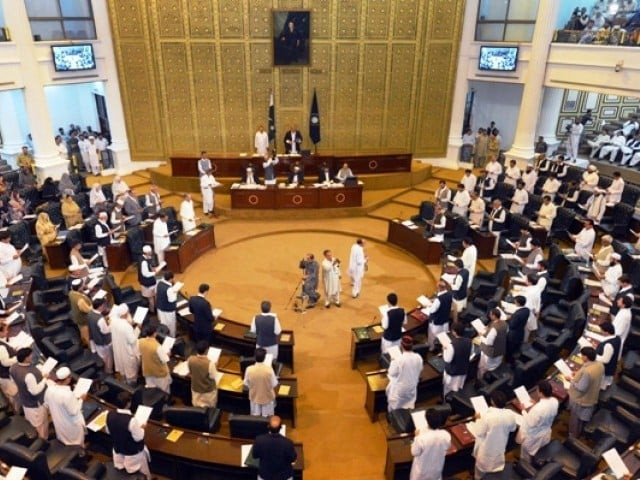K-P Assembly outshines peers in transparency
PILDAT reports it also passed highest number of bills per year between 2018 and 2023

In the period between 2018 and 2023, the Khyber-Pakhtunkhwa (K-P) Assembly has emerged as a frontrunner among the provincial assemblies in Pakistan, with a score of 8.5 out of 11 in terms of transparency and access to information.
These findings are the result of a comprehensive comparative analysis conducted by the think tank, Pakistan Institute of Legislative Development and Transparency (PILDAT). Not only did the K-P Assembly excel in terms of transparency, but it also displayed legislative productivity during its tenure, despite its dissolution seven months ahead of its scheduled term.
Read more: Polls to be held in last week of January: ECP
The K-P Assembly stands tall as the only provincial legislative body that provides live telecasts of its proceedings. It's noteworthy that the Punjab Assembly was the pioneer in introducing live webcasts of its proceedings back in 2002.
However, in a surprising turn of events, the practice was suspended in 2021, and regrettably, it has not been reinstated since.
Another aspect of transparency evaluated by PILDAT was the availability of complete attendance records of Members of Provincial Assembly (MPAs) on official websites. In this regard, the Punjab Assembly emerged as a runner-up, as it is the only assembly among the four provinces to provide comprehensive attendance records.
When assessing the overall transparency and accessibility of information provided by provincial assemblies, PILDAT's findings reveal a clear hierarchy among the four assemblies.
Khyber-Pakhtunkhwa Assembly: Leading the pack with a score of 8.5 out of 11, the K-P Assembly shines as a model of transparency and access to information.
Punjab Assembly: Securing the second position with a score of 7 out of 11, the Punjab Assembly demonstrates a substantial commitment to transparency, despite the suspension of its webcasting practice.
Balochistan Assembly: Earning a respectable score of 6.5 out of 11, the Balochistan Assembly holds the third spot, displaying commendable transparency efforts.
Sindh Assembly: Unfortunately, the Sindh Assembly lags behind the others, ranking last with a score of 5.5 out of 11. It provides the least information on its official website, signaling room for improvement in transparency measures.
Legislative Productivity
Beyond transparency, the K-P Assembly has also made a substantial impact in terms of legislative productivity. During its truncated tenure of four years and five months, it managed to pass a remarkable 188 bills. This impressive figure translates to an average of 43 bills passed annually, the highest among all provincial assemblies.
The Punjab Assembly, while not matching the K-P Assembly's pace, still performed admirably, passing 180 bills with an average of 41 bills per year. The Sindh Assembly, on the other hand, passed 149 bills during the same period, averaging 30 bills annually. However, it's important to note that the Balochistan Assembly, facing challenges unique to its context, could only pass 96 bills over its five-year term, averaging a relatively lower 19 bills per year.
Dissolutions and Sittings
One noteworthy point highlighted by PILDAT is the untimely dissolution of provincial assemblies. In January 2023, both the Punjab and K-P Assemblies were dissolved prematurely, marking a deviation from their stipulated terms. In contrast, the Sindh Assembly managed to conclude its term just before its scheduled end date in August 2023, leaving the Balochistan Assembly as the sole provincial body to complete its five-year term, doing so on August 12, 2023.
As for the number of sittings held during their respective terms, the Sindh Assembly emerges as the leader, convening a remarkable 326 sittings over five years, averaging 65 sittings annually. The Punjab Assembly, during its four-year and five-month tenure, held 274 sittings, averaging 62 sittings per year. The K-P Assembly, while known for its legislative productivity, conducted 248 sittings, averaging 56 sittings per year. In contrast, the Provincial Assembly of Balochistan convened the fewest sittings, totaling 241, and averaging 48 sittings annually.
Read: US urges ‘timely, fair’ elections in Pakistan
In terms of working hours dedicated to legislative matters, the Sindh Assembly again leads the pack, with a staggering 921 hours expended over five years. This translates to an average of 184 hours and 20 minutes per year. Balochistan Assembly follows, with 581 hours and 18 minutes (an average of 116 hours per year), while the K-P Assembly recorded 574 hours and 27 minutes (averaging 130 hours per year). The Punjab Assembly, though productive in terms of legislation, allocated 530 hours and 47 minutes (an average of 120 hours and 12 minutes per year) to its proceedings.
Attendance Record
The attendance of Chief Ministers and Leaders of the Opposition in these provincial assemblies is another important metric assessed by PILDAT. Balochistan Assembly stands out, with Chief Ministers attending the highest percentage of sittings during their five-year term. This achievement is attributed to a combined attendance rate of 31%, with notable figures such as Jam Kamal Khan and Mir Abdul Quddus Bezinjo contributing.
In contrast, the leaders of the opposition in the Punjab Assembly recorded the lowest attendance, attending only 12% of sittings during the same period. This figure is a combination of Muhammad Hamza Shehbaz Sharif and Muhammad Sibtain Khan's attendance.



















COMMENTS
Comments are moderated and generally will be posted if they are on-topic and not abusive.
For more information, please see our Comments FAQ